Leafminer: [Characteristics, Detection, Effects and Treatment]

What is leaf miner?
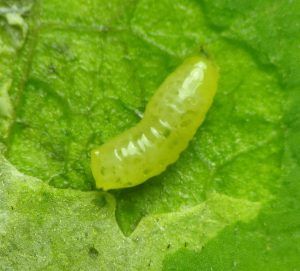 The Leafminer is a very particular intruder, since it is a dipteran insect larvae belonging to the genus Liriomyza, very efficient in invading the leaves of ornamental and horticultural crop plants, so they can become the worst nightmare, since if they are allowed to advance they can lead to significant economic losses for farmers.
The Leafminer is a very particular intruder, since it is a dipteran insect larvae belonging to the genus Liriomyza, very efficient in invading the leaves of ornamental and horticultural crop plants, so they can become the worst nightmare, since if they are allowed to advance they can lead to significant economic losses for farmers.
The main mission of the female of this species is to extract the sap from the plant with the help of her ovipositor, which can trigger the total ruin of her victim, who will wither to death, because the photosynthesis process is obstructed and it triggers the premature fall of the affected leaves, which suffer serious injuries in the form of tunnels or galleries excavated by the invasive larvae.
There are three dominant species of this invasive insect: the American lookout or Lyriomyza trifolii, the tomato leafminer or Liriomyza bryoniae, and the South American pea leafminer and L. huidobrensis.The virtual encyclopedia, Wikipedia warns that most of the mining insects are moths, or Lepidoptera, and flies, or Diptera.
But equally, some types of beetles and wasps engage in similar highly invasive behaviors.There are even leaf miners, which are micro lepidoptera, that is, tiny butterflies, or micro diptera, which are small flies.
How can we identify it?
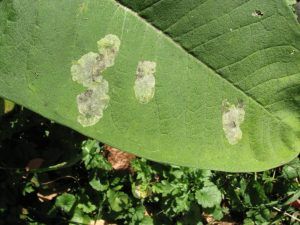 Precisely, the harassment of these larvae is evident in the ruin of the leaves of the sick plants as a result of the loss of sap, because they cause damage that can be irreparable by causing lesions in the upper and lower sides of the leaves, which suffer the destructive action of the female larvae, who, when laying their eggs, open holes to deposit them, with the aim of hatching larvae that will make their way on the plant surface to feed, damaging the cuticle of the infected leaf.
Precisely, the harassment of these larvae is evident in the ruin of the leaves of the sick plants as a result of the loss of sap, because they cause damage that can be irreparable by causing lesions in the upper and lower sides of the leaves, which suffer the destructive action of the female larvae, who, when laying their eggs, open holes to deposit them, with the aim of hatching larvae that will make their way on the plant surface to feed, damaging the cuticle of the infected leaf.
Let’s see some characteristics that allow the identification of this pest.
- Adult females are usually about 2-3 mm long and slightly larger than males.
- A female is black, but they have a yellow ventral surface and legs, with a dorsal surface of the same color.
- They have an ovipositor that helps them in the task of embedding the eggs in the invaded leaf, which can be recognized because it is oval in shape and creamy white in color.
- The males depend on the females to eat, because they previously mark the areas of the leaf where they will suck sap.
- The eggs deposited by the females take about 2 weeks if the average temperature is 30ºC, but if it is about 15ºC they will take about 7 weeks to pass to the larval stage.
- When the larvae hatch, they go through three major life stages. In the first they are transparent, later they turn from a dirty white color to ocher yellow and have a length of about 2mm.
- Before becoming a pupa, the larva digs a hole in the leaf where it lives and has a new color: it goes from yellow to reddish-brown.
- As the larva grows, the gallery in the leaf also gets wider and wider. It is identified because it looks like a path.
What plants does leaf miner affect?
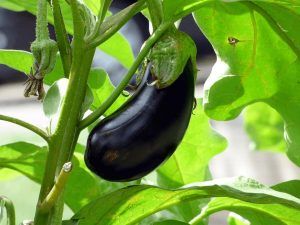 Any variety of plants can be invaded by this dipteran insect.
Any variety of plants can be invaded by this dipteran insect.
But the crops of tomatoes and cherry tomatoes, cucumbers and gherkins, aubergines, beans, gerberas, sweet and chili peppers (hot), melons and watermelons, lettuce, cabbage, potatoes, as well as crops of chrysanthemums, among many other ornamentals.
In the case of tomatoes, the leaf miners begin to act very early, damaging the seedlings from the nurseries, which is why they end up infecting the greenhouses.
Large trees such as Oaks are also affected by these annoying insects, stealing a substance called tannin, which is a defensive weapon against herbivores because they are toxins that produce animal rejection and affect their growth.
Fruit trees are also a sure victim of leafminers. Lemon, orange and lime trees, among others.
How to combat the leaf miner?
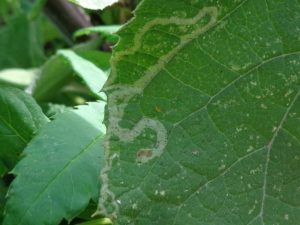 These larvae are difficult to combat because they manage to infiltrate the tissue of the leaves, to absorb the layers that have a lower amount of cellulose.
These larvae are difficult to combat because they manage to infiltrate the tissue of the leaves, to absorb the layers that have a lower amount of cellulose.
An effective mechanism to reduce the population of leafminer insects is to use trap crops, or what is the same, to use a method of intercropping in order to reduce the infestation of the main ones.
In the case of miners, species such as Aguileñas (Aquilegia) Cenizos (Quinhuilla) and the genus of perennial flowering plants Abutilon can be planted near our main crop. But the most important thing is to remove the diseased leaves as soon as possible, preventing them from falling to the ground.
It is essential to destroy them, not allowing them to compost, because the insect will remain alive. They must be burned and disposed of outside the crop or garden.It is also not recommended to allow weeds to grow, because they are a sure source of bugs.
The so-called chromatic traps also work, using the color yellow to attract the attention of these insects.This method works not only for miners. Eliminate whiteflies ,aphids, thrips.They love the color yellow.
It can be made with the help of a yellow plastic bottle (for bleach or another product), oil, soap and water. The bottle will be cut at a level of about 20 cm from the bottom, in order to build a bowl or container.
A stream of soap is applied and completed with water, so that when they are attracted by the yellow color, they will fall and remain smeared in the soapy substance, preventing them from leaving. This bowl is placed at the foot of the affected plantation and the positive results will be seen in a short time.
The other way to make a cormatic trap is to cut the plastic bottle in half, to take advantage of a full sheet and get two yellow squares. With the help of a brush, a glue for mice, honey or oil (sunflower or olive) is applied to the entire surface.
A hole is opened in the upper part and the same is hung on one of the branches of the affected plant. The ideal is that for each plant about 4 yellow posters are hung.In greenhouses, it is also appropriate to place yellow barriers, in order to capture the adult miners that attend.
What are the best products to eliminate leaf miner?
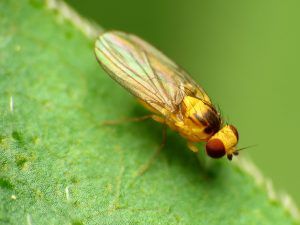 An effective formula to exterminate these mining insects is Bacillus thuringiensis, a powerful bacterium that digests caterpillars.
An effective formula to exterminate these mining insects is Bacillus thuringiensis, a powerful bacterium that digests caterpillars.
Likewise, there are other natural predators, which are much better than the use of chemical insecticides. A good help from wasps, spiders, orius, lacewings and parasitoids will never hurt.
Another very powerful natural method consists of the application of Neem Oil during irrigation sessions, in doses ranging from 3-5 ml for each liter of irrigation water used, although this will depend on the severity of the infestation.
The advantage of Neem Oil is that it combats many pests in a residual way, because its effect lasts about 3 weeks and gives the leaves a bitter taste that repels unwanted visitors.


![Photo of Types of Substrates: [Concept, Characteristics, Natural and Artificial]](https://www.complete-gardening.com/wp-content/uploads/2022/08/types-of-substrates-concept-characteristics-natural-and-artificial-390x220.jpg)
![Photo of How to Stake Tomatoes: [Utility, Installation and Procedure]](https://www.complete-gardening.com/wp-content/uploads/2022/08/how-to-stake-tomatoes-utility-installation-and-procedure-390x220.jpg)
![Photo of The Ocra: [Cultivation, Care, Substrate, Irrigation and Pests]](https://www.complete-gardening.com/wp-content/uploads/2022/08/the-ocra-cultivation-care-substrate-irrigation-and-pests-390x220.png)